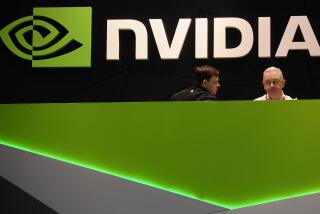Motorola, AMD in Chip Alliance
SAN FRANCISCO — Semiconductor manufacturers Motorola Inc. and Advanced Micro Devices Inc. announced a wide-ranging cross-licensing agreement Monday that could help each company compete more effectively in key markets.
A central element of the agreement gives Sunnyvale, Calif.-based AMD access to Motorola’s technology for producing copper-based microprocessors. Industry experts say the copper technology should allow for the production of less expensive and more powerful processors with smaller circuitry than those based on today’s aluminum technology. AMD needs the copper methods to keep pace with industry leader Intel Corp.
Chief Executive W.J. Sanders III said AMD spends $500 million a year on research and development, a huge outlay for a company that had revenue of $2.4 billion in 1997. The agreement should ease that burden by reducing AMD’s development costs for copper chips.
“We do not expect our R&D; spending to go down, but it may increase at a slower rate,” Sanders said. “The cost of developing these technologies is so high that if you can get to the market faster without greatly increasing R&D; spending, that’s a huge advantage.”
“We’ll have production volumes of 1-gigahertz K7s in the year 2000,” Sanders added. This refers to the speed of AMD’s next-generation K7 microprocessors, the brains of PCs. The company’s current flagship chip, the K6, runs as fast as 350 megahertz--about one-third as fast as AMD says the copper-based K7s will operate.
Sanders predicted that the K7 will offer price and performance advantages over the fastest Intel microprocessors available at that time.
Michael Feibus, a chip analyst with Mercury Research in Scottsdale, Ariz., called the agreement a natural fit for both companies, but he remains skeptical about AMD’s ability to overtake Intel.
“Intel has copper on its agenda in about the same time frame,” Feibus said. The alliance “basically keeps AMD in the ballgame for the longer term.”
AMD’s prospects are looking up, however, given that it recently beat Intel to market with a set of specialized 3-D features and now can move aggressively into copper technology, said Linley Gwennap, editorial director of the industry newsletter Microprocessor Report.
But Gwennap cautioned that copper might offer only a 10% speed advantage over comparable aluminum-based chips. “AMD is going to have to execute better in all phases, including design and manufacturing, to really get ahead of Intel,” he said.
“Copper is not a be-all and end-all for getting to those kinds of [gigahertz] speeds,” said Nathan Brookwood, an analyst for research firm Dataquest in San Jose. “Whether it’s done with copper or aluminum or maple syrup hardly matters.”
Sanders said that by 2000, AMD will also develop PC-on-a-chip products, which consolidate most standard PC functions on a single microprocessor.
Both National Semiconductor Corp. and Motorola have announced similar initiatives. But AMD’s efforts in that direction may be limited to the market for information appliances based on Microsoft’s Windows CE operating system, a version of Windows for hand-held computers, set-top boxes and other products, according to Sanders.
The agreement gives Schaumburg, Ill.-based Motorola a superior flash-memory technology for its embedded-processor division.
Embedded processors control a wide range of information appliances, such as cellular phones and set-top boxes, as well as specialized functions in cars and other products. Flash memory retains its programming information even when the device is turned off. Flash chips can also be upgraded using software.
Motorola executive C.D. Tam predicted that the combination of AMD and Motorola technologies will soon allow the production of automobiles with processors that custom-tune engine performance to reflect the environmental conditions of the area through which the car is traveling.
Motorola shares rose 63 cents to close at $54.31; AMD shares rose 81 cents to close at $17.38.
More to Read
Inside the business of entertainment
The Wide Shot brings you news, analysis and insights on everything from streaming wars to production — and what it all means for the future.
You may occasionally receive promotional content from the Los Angeles Times.









